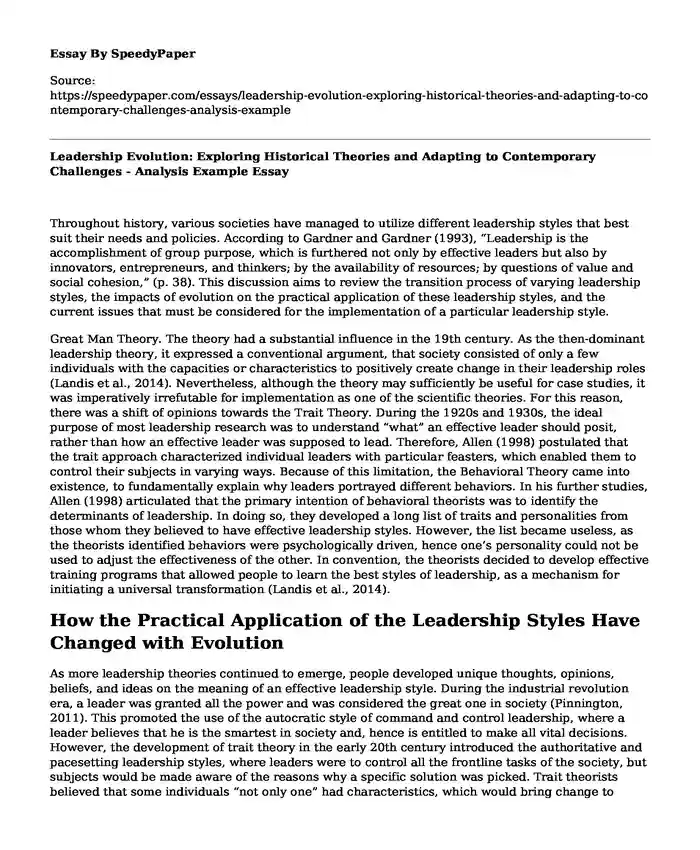
| Essay type: | Analytical essays |
| Categories: | Leadership analysis Management Society |
| Pages: | 3 |
| Wordcount: | 783 words |
Throughout history, various societies have managed to utilize different leadership styles that best suit their needs and policies. According to Gardner and Gardner (1993), “Leadership is the accomplishment of group purpose, which is furthered not only by effective leaders but also by innovators, entrepreneurs, and thinkers; by the availability of resources; by questions of value and social cohesion,” (p. 38). This discussion aims to review the transition process of varying leadership styles, the impacts of evolution on the practical application of these leadership styles, and the current issues that must be considered for the implementation of a particular leadership style.
Great Man Theory. The theory had a substantial influence in the 19th century. As the then-dominant leadership theory, it expressed a conventional argument, that society consisted of only a few individuals with the capacities or characteristics to positively create change in their leadership roles (Landis et al., 2014). Nevertheless, although the theory may sufficiently be useful for case studies, it was imperatively irrefutable for implementation as one of the scientific theories. For this reason, there was a shift of opinions towards the Trait Theory. During the 1920s and 1930s, the ideal purpose of most leadership research was to understand “what” an effective leader should posit, rather than how an effective leader was supposed to lead. Therefore, Allen (1998) postulated that the trait approach characterized individual leaders with particular feasters, which enabled them to control their subjects in varying ways. Because of this limitation, the Behavioral Theory came into existence, to fundamentally explain why leaders portrayed different behaviors. In his further studies, Allen (1998) articulated that the primary intention of behavioral theorists was to identify the determinants of leadership. In doing so, they developed a long list of traits and personalities from those whom they believed to have effective leadership styles. However, the list became useless, as the theorists identified behaviors were psychologically driven, hence one’s personality could not be used to adjust the effectiveness of the other. In convention, the theorists decided to develop effective training programs that allowed people to learn the best styles of leadership, as a mechanism for initiating a universal transformation (Landis et al., 2014).
How the Practical Application of the Leadership Styles Have Changed with Evolution
As more leadership theories continued to emerge, people developed unique thoughts, opinions, beliefs, and ideas on the meaning of an effective leadership style. During the industrial revolution era, a leader was granted all the power and was considered the great one in society (Pinnington, 2011). This promoted the use of the autocratic style of command and control leadership, where a leader believes that he is the smartest in society and, hence is entitled to make all vital decisions. However, the development of trait theory in the early 20th century introduced the authoritative and pacesetting leadership styles, where leaders were to control all the frontline tasks of the society, but subjects would be made aware of the reasons why a specific solution was picked. Trait theorists believed that some individuals “not only one” had characteristics, which would bring change to society (Pinnington, 2011). Therefore, the led people, by acting as illustrators, as subjects emulate their traits, which were believed to be productive. Later in the 20th century, the emergence of behavioral theorists transitioned the beliefs, by supporting the use of democratic leadership style, and related styles. According to the theory, "everyone" had personal traits that were psychologically driven. As a result, people would undergo training, to learn and acquire exceptional leadership styles (Pinnington, 2011). Because the theory believes that everyone has the potential to lead when trained, it motivated the use of a democratic form of leadership where leaders and subjects would mutually consult and make joint decisions.
Current Issues in Applying Leadership Theory
Cultural diversity is one of the most crucial factors or determinants of the application of different leadership theories (Gregory-Mina, 2006). A leader needs to understand the culture of the environment before making decisions on which style to use. From this, issues such as social status, age, gender, sex, language, and race within a targeted population or society, can be considered before applying a specific theory of leadership.
References
Allen, G. (1998). Leading. Supervision: Management modern. Retrieved from http://ollie. dcccd. edu. http://sutlib2.sut.ac.th/sut_contents/H132746.pdf
Gardner, J., & Gardner, J. W. (1993). On leadership. Simon and Schuster. https://books.google.com/books?hl=en&lr=&id=NxXGFwDhLicC&oi=fnd&pg=PR9&dq=Gardner,+J.W.+(1990).+On+leadership.+New+York:+Free+Press&ots=TBWwSsSBkB&sig=w1g45WbcYvb8XBXXAJty90HZbac
Gregory-Mina, H. (2006). Four leadership theories address contemporary leadership issues as the theories relate to the scholarship, practice, and leadership model. Academic Leadership-Online Journal, 7(3). https://www.academicleadership.org/index.php/alj/article/download/404/373
Landis, E. A., Hill, D., & Harvey, M. R. (2014). A synthesis of leadership theories and styles. Journal of Management Policy and Practice, 15(2), 97. http://www.m.www.na-businesspress.com/JMPP/LandisEA_Web15_2_.pdf
Pinnington, A. H. (2011). Leadership development: Applying the same leadership theories and development practices in different contexts? Leadership, 7(3), 335-365. https://journals.sagepub.com/doi/abs/10.1177/1742715011407388
Cite this page
Leadership Evolution: Exploring Historical Theories and Adapting to Contemporary Challenges - Analysis Example. (2023, Dec 03). Retrieved from https://speedypaper.com/essays/leadership-evolution-exploring-historical-theories-and-adapting-to-contemporary-challenges-analysis-example
Request Removal
If you are the original author of this essay and no longer wish to have it published on the SpeedyPaper website, please click below to request its removal:
- Free Essay on the Immigrant Experience in American History
- Project Management Essay Sample: Equipping a Sound (Record) Studio
- White Establishment: Dominance & Control in the USA. Free Essay
- Free Paper Example Containing the Appeal to Amend the Federal Licensing System
- Essay Sample on The Wilsonian Movement
- Free Essay Example. Sex, Gender, and Domestic Violence
- Essay on Championing Equality: Gender Justice and Social Inclusion in South Africa
Popular categories




